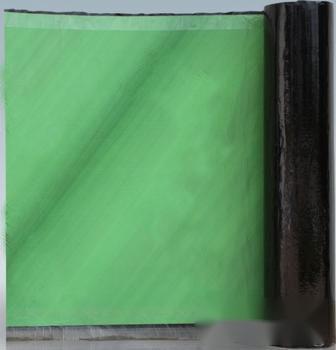I. Product Introduction
RAM-CL Fast Reaction High Adhesive Strength Cross-Laminated Self-Adhesive Waterproof Membrane is a high-performance, cold-application self-adhesive waterproof membrane made from specially cross-laminated high-density polyethylene (HDPE) strong film and high polymer self-adhesive rubber asphalt through a special composite process. It has excellent dimensional stability, thermal stability, UV resistance, and bi-directional tear resistance.
The high-strength cross-laminated film used in this product is formed through a cross-laminating process, resulting in a high-strength HDPE film with identical longitudinal and transverse elongation rates, preventing deformation of the membrane and providing a more aesthetically pleasing and reliable waterproof effect.
The pressure-sensitive self-adhesive layer can quickly bond with the concrete substrate, and its excellent self-healing properties and localized self-locking water performance significantly reduce the likelihood of leaks. The high polymer (chain segments) in the membrane adhesive forms an interpenetrating network structure with the hydration products of cement (silicate network), ultimately resulting in continuous mechanical bonding, sealing tightly onto cementitious materials.
II. Bonding Mechanism Diagram of the Product and Substrate
a, Self-adhesive layer releases crack stress
Ordinary membranes are unidirectional stretched membranes, and self-adhesive membranes produced using such films tend to wrinkle when exposed to temperature changes after installation, and excessive deformation can easily cause the membranes to tear.
This high-strength film is produced through multiple processes, including cross-lamination and layering, from specially formulated films. It overcomes many shortcomings of ordinary membranes, exhibiting high tensile strength, UV resistance, and no bubbling, with technical indicators meeting national standards for Type II waterproof membranes, making it suitable as a surface material for waterproof membranes.
b, Excellent Physical Properties
1, Nail tear strength and nail water tightness are superior to ordinary surface membranes.
2, Self-adhesive membranes produced with strong cross-laminated films have a much stronger grip on roofing fasteners like nails compared to ordinary waterproof membranes, and they have higher tear strength. This is because when a nail passes through the strong cross-laminated film, the overlapping films in both directions wrap around the nail, distributing stress evenly and making tearing difficult. Ordinary films only have high longitudinal strength, while their transverse strength is very low.
3, Excellent tensile strength and bi-directional tear resistance, with good weather resistance.
4, Good dimensional stability, no wrinkling, and more reliable waterproofing.
c, Friendly Construction Performance
1, The membrane bonds firmly with the structure; if there is any local damage to the membrane, water will be confined to a small area without leaking. Even if individual leaks occur, the leak points will coincide with the damage points, making repairs easier. The unique "self-healing function" of the self-adhesive layer allows puncture points to heal themselves.
2, Better adaptability to the construction environment. Can be applied on damp substrates without the need for primers, solvents, or fuels, ensuring timely completion while avoiding environmental pollution and being friendly to the construction environment.
3, Features an apple green surface film. Compared to silver-white surface films, it eliminates light pollution.
4, Can adapt to climate changes in hot and cold regions and can form good adhesion at irregular shapes without causing hollow areas.
III. Product Application Scope
RAM-CL Fast Reaction High Adhesive Strength Cross-Laminated Self-Adhesive Waterproof Membrane is used for non-exposed roofs, underground waterproofing projects, as well as waterproofing for open-cut subways, tunnels, water pools, and channels, especially suitable for projects where open flames are not allowed; bonded with cement mortar to the substrate, self-adhesive overlaps are recommended between membranes.













